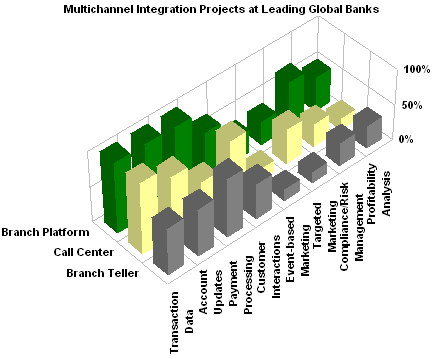Multichannel Integration: A Global Survey
Abstract
Milan, Italy Tokyo, Japan March 18, 2004A Celent survey indicates that over 80% of major banks worldwide are currently engaged in or planning channel integration projects. Many top tier institutions aim to achieve full integration by 2007. As bank systems become inexorably more complex, the costin monetary, resource and organizational termsof developing and maintaining multiple delivery systems becomes ever more prohibitive. At the same time, banks are trying to construct cohesive strategies for focused customer service and sales out of the jumble of technology and business silos typical of modern banking. Leading banks are concluding that multichannel integration can address many of these challenges, and many have initiated long-term projects to enable real-time, uniform access to customer and transaction data across all delivery channels.  Celents survey indicates that the majority of multichannel integration projects are focused on the branch, call center and Internet channels. With the exception of Internet banking, the self-service channels ATMs, IVR (Interactive Voice Response), wireless and iDTVare less of a priority. Banks are concentrating on meat-and-potatoes functionality: enabling real-time sharing of financial transactions and customer interactions, followed by data analysis for compliance and risk management purposes. Sophisticated sales capabilities such as targeted marketing are less of a priority at most banks, despite advanced projects at some forward-looking institutions (particularly in Europe) and the potential of channel integration for enabling next-generation CRM. In addition to the survey, the report discusses technology and business drivers for multichannel integration, as well as technology choicesenterprise platforms versus middleware and vendor solutions applicable to channel integration. Regional surveys of North America, Europe and Asia/Pacific are also included. "What has been lacking for most financial institutions is uniform customer data through channels, making it difficult for them to cross-sell products and services," commented Isabella Cagnazzo Fonseca, a Senior Analyst at Celent and co-author of the report. "Increased competition, the need to update technology, and adding productivity to channels are driving many channel integration projects," she added. "Long-term cost efficiencies, shortened development cycles, and faster time-to-market for new products and services are a compelling argument for basing multichannel integration on enterprise platforms," added Neil Katkov, co-author of the report. "At the same time, we recognize that up-front cost considerations and the need to address immediate pain points compel many banks to opt for the more ad-hoc middleware approach." The 56-page report contains 24 figures and 11 tables. A is available online. |
of Celent Communications' Retail Banking research service can download the report electronically by clicking on the icon to the left. Non-members should contact info@celent.com for more information. |
|

